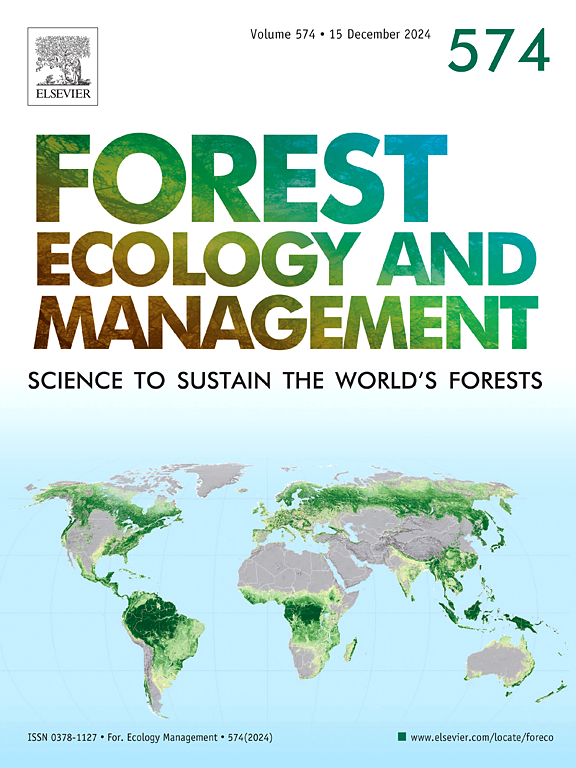Contrasting wood carbon quality of angiosperms and gymnosperms drives fungal-mediated decomposition responses to nutrient enrichment
IF 3.7
2区 农林科学
Q1 FORESTRY
引用次数: 0
Abstract
Deadwood occupies about eight percent of the global forest carbon stock. Its high lignin content and low nutrient concentration typically inhibit microbial activity, yet the combined influence of these wood properties on fungi, the main decomposers of wood, has not been thoroughly explored. Here we tested how wood carbon quality (e.g., lignin carbon and cellulose carbon) and nutrient availability interactively shape fungal communities, microbial respiration, and decomposition rates of diverse angiosperm and gymnosperm trees under nitrogen (N; 100 kg N ha⁻¹ yr⁻¹), phosphorus (P; 15 kg P ha⁻¹ yr⁻¹), and combined N + P additions in a subtropical forest. Nutrient additions had opposing effects on fungal communities in angiosperms and gymnosperms and accelerated decomposition more in gymnosperms compared to angiosperms. Specifically, in relatively nutrient-rich, low lignin carbon of angiosperms, nutrient additions shifted fungal communities from Basidiomycota to Ascomycota dominance. This significantly increased fungal diversity, boosted the activities of hydrolytic carbon-acquiring enzymes, and enhanced cellulolytic carbon decomposition. In nutrient-poor, high lignin carbon of gymnosperms, nutrient additions strengthened Basidiomycota dominance, reduced fungal diversity, and promoted decomposition of lignin-derived carbon. Our study highlights that carbon quality mediates how nutrient additions accelerate wood decomposition by adjusting the dominant taxa of communities with decomposition traits adapted to target specific carbon compounds. It provides important information to forest managers aiming to boost forest carbon sequestration through selection of distinct tree species under global changes.
被子植物和裸子植物木材碳质量的差异驱动真菌介导的养分富集分解反应
枯木约占全球森林碳储量的8%。其高木质素含量和低营养物质浓度通常会抑制微生物活性,但这些木材特性对木材主要分解者真菌的综合影响尚未得到深入探讨。在这里,我们测试了木材碳质量(如木质素碳和纤维素碳)和养分有效性如何相互作用地影响真菌群落、微生物呼吸和不同被子植物和裸子植物树木在氮(N;100 kg N ha(⁻¹yr),磷(P;15 kg P ha⁻¹yr⁻),并在亚热带森林中添加N + P。营养添加对被子植物和裸子植物真菌群落的影响相反,裸子植物的真菌分解速度比被子植物快。具体来说,在营养相对丰富、木质素碳含量较低的被子植物中,营养物质的添加使真菌群落从担子菌科向子囊菌科转变。这显著增加了真菌的多样性,提高了水解碳获取酶的活性,并促进了纤维素分解碳。在营养贫乏、木质素碳含量高的裸子植物中,添加营养物质可以增强担子菌的优势,降低真菌的多样性,促进木质素碳的分解。我们的研究强调,碳质量通过调节分解特性适应特定碳化合物的群落的优势分类群来调节营养添加如何加速木材分解。这为森林管理者在全球变化下通过选择不同树种来促进森林碳固存提供了重要信息。
本文章由计算机程序翻译,如有差异,请以英文原文为准。
求助全文
约1分钟内获得全文
求助全文
来源期刊

Forest Ecology and Management
农林科学-林学
CiteScore
7.50
自引率
10.80%
发文量
665
审稿时长
39 days
期刊介绍:
Forest Ecology and Management publishes scientific articles linking forest ecology with forest management, focusing on the application of biological, ecological and social knowledge to the management and conservation of plantations and natural forests. The scope of the journal includes all forest ecosystems of the world.
A peer-review process ensures the quality and international interest of the manuscripts accepted for publication. The journal encourages communication between scientists in disparate fields who share a common interest in ecology and forest management, bridging the gap between research workers and forest managers.
We encourage submission of papers that will have the strongest interest and value to the Journal''s international readership. Some key features of papers with strong interest include:
1. Clear connections between the ecology and management of forests;
2. Novel ideas or approaches to important challenges in forest ecology and management;
3. Studies that address a population of interest beyond the scale of single research sites, Three key points in the design of forest experiments, Forest Ecology and Management 255 (2008) 2022-2023);
4. Review Articles on timely, important topics. Authors are welcome to contact one of the editors to discuss the suitability of a potential review manuscript.
The Journal encourages proposals for special issues examining important areas of forest ecology and management. Potential guest editors should contact any of the Editors to begin discussions about topics, potential papers, and other details.
 求助内容:
求助内容: 应助结果提醒方式:
应助结果提醒方式:


